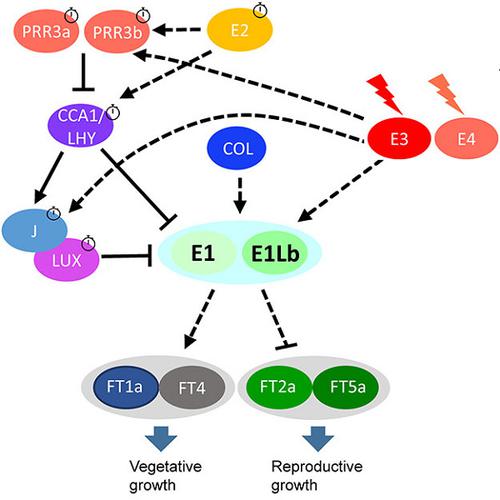当前位置:
X-MOL 学术
›
J. Integr. Plant Biol.
›
论文详情
Our official English website, www.x-mol.net, welcomes your
feedback! (Note: you will need to create a separate account there.)
Molecular mechanisms for the photoperiodic regulation of flowering in soybean
Journal of Integrative Plant Biology ( IF 9.3 ) Pub Date : 2020-10-14 , DOI: 10.1111/jipb.13021 Xiaoya Lin 1 , Baohui Liu 1, 2 , James L Weller 3 , Jun Abe 4 , Fanjiang Kong 1, 2
Journal of Integrative Plant Biology ( IF 9.3 ) Pub Date : 2020-10-14 , DOI: 10.1111/jipb.13021 Xiaoya Lin 1 , Baohui Liu 1, 2 , James L Weller 3 , Jun Abe 4 , Fanjiang Kong 1, 2
Affiliation

|
Photoperiodic flowering is one of the most important factors affecting regional adaptation and yield in soybean (Glycine max). Plant adaptation to long-day conditions at higher latitudes requires early flowering and a reduction or loss of photoperiod sensitivity; adaptation to short-day conditions at lower latitudes involves delayed flowering, which prolongs vegetative growth for maximum yield potential. Due to the influence of numerous major loci and quantitative trait loci (QTLs), soybean has broad adaptability across latitudes. Forward genetic approaches have uncovered the molecular basis for several of these major maturity genes and QTLs. Moreover, the molecular characterization of orthologs of Arabidopsis thaliana flowering genes has enriched our understanding of the photoperiodic flowering pathway in soybean. Building on early insights into the importance of the photoreceptor phytochrome A, several circadian clock components have been integrated into the genetic network controlling flowering in soybean: E1, a repressor of FLOWERING LOCUS T orthologs, plays a central role in this network. Here, we provide an overview of recent progress in elucidating photoperiodic flowering in soybean, how it contributes to our fundamental understanding of flowering time control, and how this information could be used for molecular design and breeding of high-yielding soybean cultivars.
中文翻译:

大豆开花光周期调控的分子机制
光周期开花是影响大豆( Glycine max )区域适应和产量的最重要因素之一。植物适应高纬度地区的长日照条件需要提早开花并降低或丧失光周期敏感性;适应低纬度地区的短日照条件涉及延迟开花,从而延长营养生长以获得最大产量潜力。由于众多主要基因座和数量性状基因座(QTL)的影响,大豆具有广泛的跨纬度适应性。正向遗传方法揭示了其中几个主要成熟基因和 QTL 的分子基础。此外,拟南芥开花基因直系同源物的分子表征丰富了我们对大豆光周期开花途径的理解。基于对光感受器光敏色素 A 重要性的早期认识,一些生物钟成分已被整合到控制大豆开花的遗传网络中:E1 是FLOWERING LOCUS T直向同源物的抑制子,在该网络中发挥着核心作用。在这里,我们概述了阐明大豆光周期开花的最新进展,它如何有助于我们对开花时间控制的基本理解,以及如何将这些信息用于高产大豆品种的分子设计和育种。
更新日期:2020-10-14
中文翻译:

大豆开花光周期调控的分子机制
光周期开花是影响大豆( Glycine max )区域适应和产量的最重要因素之一。植物适应高纬度地区的长日照条件需要提早开花并降低或丧失光周期敏感性;适应低纬度地区的短日照条件涉及延迟开花,从而延长营养生长以获得最大产量潜力。由于众多主要基因座和数量性状基因座(QTL)的影响,大豆具有广泛的跨纬度适应性。正向遗传方法揭示了其中几个主要成熟基因和 QTL 的分子基础。此外,拟南芥开花基因直系同源物的分子表征丰富了我们对大豆光周期开花途径的理解。基于对光感受器光敏色素 A 重要性的早期认识,一些生物钟成分已被整合到控制大豆开花的遗传网络中:E1 是FLOWERING LOCUS T直向同源物的抑制子,在该网络中发挥着核心作用。在这里,我们概述了阐明大豆光周期开花的最新进展,它如何有助于我们对开花时间控制的基本理解,以及如何将这些信息用于高产大豆品种的分子设计和育种。











































 京公网安备 11010802027423号
京公网安备 11010802027423号